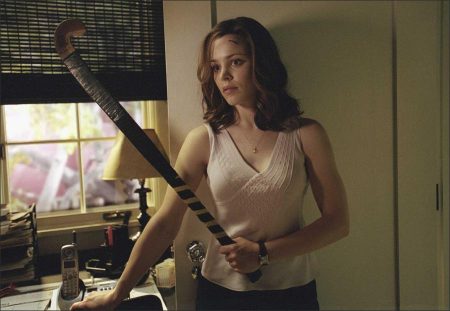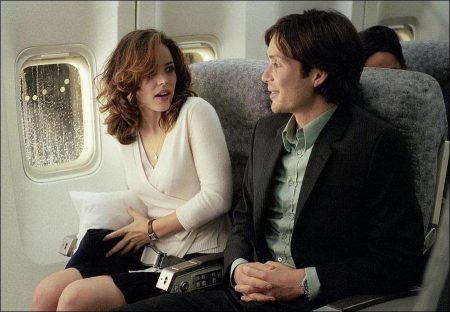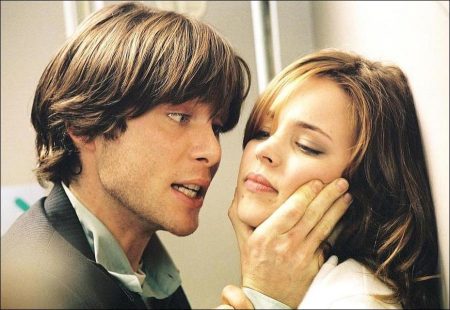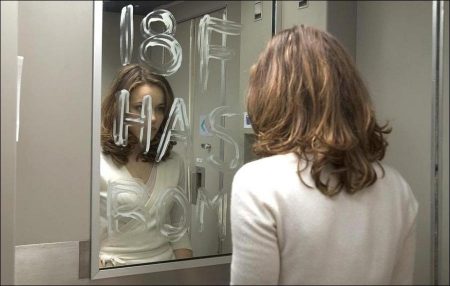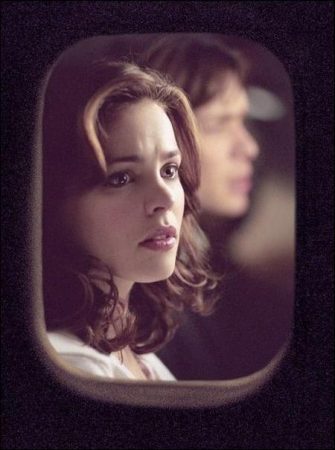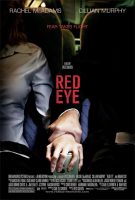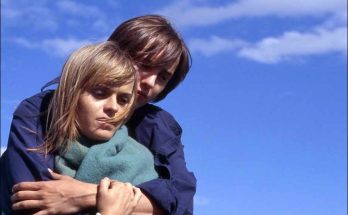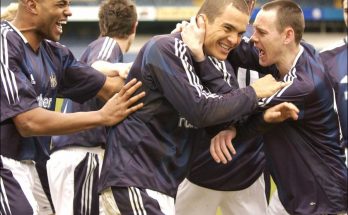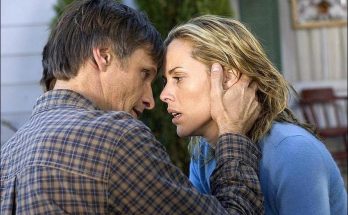About the Production: Take Off
Red Eye Movie Trailer. Director Wes Craven, who is best known for such classic horror films as “A Nightmare on Elm Street” and the “Scream” franchise, adopted a more subtle approach to keeping audiences on the edge of their seats in his new thriller, “Red Eye.”
“This is definitely not a horror film; it’s a psychological thriller,” he states. “There aren’t people being chased by a maniac with a butcher knife, and nobody wears a mask-except in the sense of presenting himself as one thing and then turning out to be something totally different. After all,” he smiles, “you never know who you are going to sit next to on a plane.”
It was that central and almost universally shared experience that first sparked the imagination of screenwriter Carl Ellsworth. “All sorts of characters come on to airplanes. Sitting there, watching them come down the aisle, we’ve all had those thoughts like, `What’s that guy about?’ or `Oh, I don’t want that person sitting next to me.’ The story originated out of that.”
Ellsworth offers that he also found inspiration in the movie “Phone Booth,” whose protagonist spends virtually the entire film trapped in the title’s set piece. “You could say that movie is a claustrophobic thriller in that there is a sniper holding a guy hostage in a phone booth.” Nevertheless, he observes, “There is still a considerable amount of space between the good guy and the bad guy. I started to think about how I could condense that space even more. Could I have my protagonist and antagonist literally trapped together, side by side, and sustain the action and suspense?
With `Red Eye,’ I think the answer is emphatically `yes,’ because the tension for me is generated out of this very compelling conversation between these two individuals, Lisa and Jackson, which starts out innocently enough, but then suddenly develops into something much more sinister. I’m hoping audiences will go along for the ride-a different type of ride because it hinges on the words that pass between these two people, but a ride just the same.”
Most of that ride takes place within the confines of a plane at 30,000 feet, which executive producer Mason Novick says adds to the inherent tension. “If you’re on a plane, there’s truly nowhere to go. We didn’t have to invent a scenario for why the doors are locked or why they can’t get out for this reason or that… Lisa is stuck in that little seat with this guy who is threatening her with this horrific plot, and there is nowhere to run. It makes it very claustrophobic and `in your face.’”
Ellsworth notes that he also had to find a way to keep Lisa and Jackson in a virtual vacuum, even as they are surrounded by 150 fellow travelers. “You might think that with a planeload of people around her, Lisa might be able to find some help during this ordeal, but Jackson has planned for those contingencies. So even though she could theoretically scream for help, it’s just not going to happen.”
Ellsworth’s screenplay eventually came into the hands of producer Marianne Maddalena, who is a longtime associate of director Wes Craven. “I read it and I thought it was wonderful,” she states. “It was exactly what I had been looking for-a nice, tight little thriller-but at that point in time, Wes was exhausted. We were filming `Cursed,’ and he was planning his marriage at the same time. He was overwhelmed, so when I told him about `Red Eye,’ he said, `I can’t; I’m too busy.’ I said, `Just read it. You’re going to love it,’ and, as I said, he read it and loved it.”
Craven confirms, “I am always most attracted to a project by the script, and the first time I read the script for `Red Eye,’ I felt it was a page-turner. It just compelled you to see what was going to happen next. You know, a director can do nothing if he doesn’t have a good script, and this screenplay by Carl Ellsworth was remarkably well constructed and very original. I felt it was a great opportunity to show my stuff in something other than a horror movie, and yet the story had all the elements for suspense and the kinds of surprises I enjoy using to keep people on the edge of their seats.”
“It was a great day when we got the phone call that Wes Craven was interested in the script,” Novick recalls. “Everyone was excited, saying, `This guy is a legend.’ Most of us grew up watching his movies. As soon as we heard he wanted to do it, we knew we had to make it happen. From there, everything went ahead very smoothly.”
Working on his first feature film, Ellsworth states that having Craven at the helm was “a privilege, a real dream come true. Wes brought so many things to the script that added to the scare factor. He’s just the master.”
Maddalena comments that, in addition to drawing on Craven’s gift for generating fear, “Red Eye” also tapped another of the director’s strong suits. “I thought this was a perfect movie for Wes to direct because, if you look at most of his movies, they are character-driven thrillers. They may happen to have Freddie Kruger or, say, the ghost from `Scream,’ but really they are about young people surviving these horrible situations and finding the strength to fight back against whatever is going on. He is really an actor’s director, and this was such a good opportunity to work with great actors in a dramatic situation. For much of the movie, it’s really just two characters together on a plane, so it was great for him to be able to concentrate on that…on performance.”
The Plane Facts
Principal photography on “Red Eye” began at Ontario International Airport, located about 60 miles east of Los Angeles. Production designer Bruce Alan Miller and his team redressed the main terminal to resemble Dallas International Airport. Given the current conditions surrounding airport security, it was almost impossible for any large airport to accommodate an entire production team for any length of time. Miller comments, “We couldn’t shoot past security checkpoints at most airports, so the logistics of dealing with this massive film company were complicated, but Ontario was able to give us the access we needed to film.”
In addition to Ontario, some filming was accomplished at the Tom Bradley Terminal at Los Angeles International Airport. The company also traveled to Miami, where “Red Eye’s” climactic chase scene was filmed at Miami International Airport.
A beautiful older house in the Hancock Park section of Los Angeles became the Reisert home, where Jackson and Lisa engage in a nail-biting game of cat and mouse. Charles Keefe’s hotel room-which underwent a rather extreme makeover, courtesy of special effects supervisor Ron Bolanowski and his department-was constructed on a soundstage at Los Angeles’ Raleigh Studios.
Another soundstage at Raleigh Studios became the home of Fresh Air Flight 1019 from Dallas to Miami, where much of the drama of “Red Eye” unfolds in the close quarters of the coach section. Obviously, space constraints made it impossible to shoot on an actual plane, so Miller and his team reconfigured a rented aircraft to fit the specifications of a Boeing 767. “We looked at various airplane designs-wide bodies, long bodies, seating patterns-and decided to go with a two-three-two seating section, which is a 767. There wasn’t a 767 available to rent for this purpose, so we took pieces from different airplanes and put them together. Everything from the overhead baggage compartments to the lighting, the seats, and the galleys was refitted to look like a 767.”
The airplane mock-up could be taken apart in sections to facilitate filming. Wes Craven and his cinematographer, Robert Yeoman, employed different camera angles to intensify Lisa’s sense of entrapment. Craven expounds, “I had a crane gantry constructed along the top of the plane set so we could pull out panels and have a camera swoop down aisles and come up over people and back down. There are occasional uses of sweeping camera moves, mostly for transitional purposes, but for the most part, everything is compressed within those two seats, which contributes to the claustrophobic feeling…the pressure-cooker closeness of this man, sitting on the aisle, who has this young woman absolutely trapped against the bulkhead, both physically and psychologically.”
Executive producer Mason Novick notes, “There are several challenges that come with shooting on a plane. A four-hour flight can start to feel claustrophobic, so you can imagine what it must be like after six weeks of being in this confined space. Another big issue was, because it is on an airplane, no one is coming and going, so, in addition to the cast, we had to keep a group of about 80 extras who wore the same clothes and sat in the same seats day in and day out.”
“We all got to know one another very, very well,” Craven attests. “There were some close friendships formed: we had a group of poker buddies in one section, and there was even a couple who celebrated their 25th wedding anniversary while we were shooting. It became sort of familial in a way.”
Belying the often ominous nature of his movies, Wes Craven has a reputation for keeping the atmosphere on his sets light and fun. Producer Marianne Maddalena offers, “We’ve been told that our sets are the most fun, and I think it’s because Wes treats everybody the same. There’s no screaming or yelling, so people like him and want to do their best for him. Our philosophy is that, when we’re making a movie, we’re at work more than we are at home, and we want everyone to have a good time.”
That being said, “fun” might not have been the first word that came to mind as the cast and crew were experiencing some very realistic turbulence at the hands of Bolanowski’s special effects department. To shake up the plane and its passengers, the effects group built a hydraulic deck measuring 105-feet long and 24-feet wide. The mock-up of the 767 was built on the deck, which in turn rested on a cushion of 50 specialized air bags, each capable of lifting 8,000 pounds. Bolanowski explains, “By inflating and deflating the airbags, we could raise and lower the deck, and we had hydraulic rams connected to the sides of the platform, which could shake it to simulate turbulence.”“Anytime I wanted to have turbulence hit the plane, they were able to rock that set from a mild bump to a wild rollercoaster ride. It was a great combination of production design and mechanical design,” Craven states.
The simulated turbulence had the desired effect on the cast. “They did a remarkable job with the hydraulics, but it could get pretty rough,” Rachel McAdams acknowledges. “It was really moving and shaking; it felt so real at times that you could feel a sense of motion sickness. But it was great because it really helped inform the character and the anxiety and terror of the situation.”
Cillian Murphy says that the terror of “Red Eye” is amplified by the fact that it touches on concerns that many of us share. “Fear of flying is such a common thing, especially in the climate in which we live now, and most people hate sitting beside strangers on a plane. I think this film taps into all those fears and anxieties… and when you have Wes Craven directing, you know you’re definitely in for something scary.”
The director, who has scared more than his share of audiences, relates, “My feeling about audiences wanting to experience fear is not that they will go to a movie to be made afraid, but that they will go to have the fears they hold inside them all the time put into a narrative that gives them some order and resolution. There is actually a lifting of fears in a scary movie. The audience may be temporarily afraid in the film, but they know in the back of their minds that it’s safe and they are surrounded by other people that are going through the same thing, so there’s a communal thing happening. `Red Eye’ takes these deep-set fears about traveling, about our fellow human beings, about all those types of things, and puts them into a story that gives them a resolution… an ending we can all live with.”
Red Eye (2005)
Directed by: Wes Craven
Starring: Rachel McAdams, Cillian Murphy, Brittany Oaks, Kyle Gallner, Laura Johnson, Max Kasch, Jayma Mays, Angela Paton, Suzie Plakson, Mary Kathleen Gordon
Screenplay by: Carl Ellsworth
Production Design by: Bruce Alan Miller
Cinematography by: Robert D. Yeoman
Film Editing by: Stuart Levy, Patrick Lussier
Costume Design by: Mary Claire Hannan
Set Decoration by: Maggie Martin
Art Direction by: Andrew Max Cahn, Richard Fojo
Music by: Marco Beltrami
MPAA Rating: PG-13 for some intense sequences of violence, and language.
Distributed by: Dreamworks Pictures
Release Date: August 19, 2005
Views: 362
